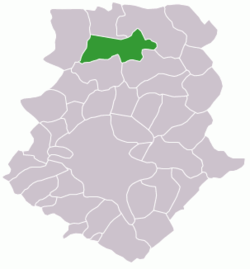Snagov
| Snagov | |
|---|---|
| Commune | |
 Location within the county | |
 Snagov Location within the county | |
| Coordinates: 44°42′32″N 26°10′17″E / 44.70889°N 26.17139°E | |
| Country |
|
| County | Ilfov County |
| Population (2002)[1] | 6,041 |
| Time zone | EET (UTC+2) |
| • Summer (DST) | EEST (UTC+3) |
Snagov (population: 6,041) is a commune, located 40 km north of Bucharest in Ilfov County, Romania. According to the 2002 census, 99.2% of the population is ethnic Romanian. The commune is composed of five villages: Ciofliceni, Ghermănești, Snagov, Tâncăbești and Vlădiceasca. Snagov is a popular holiday resort, and many villas have lately been built on the shores of Snagov lake.
The name is of probably Bulgarian origin, from the word sneg (meaning "snow"). It might also derived from the Bulgarian snaga, meaning "human body".
History
Archeologists confirmed human presence of inhabitants since 400 BC. Snagov village was built around the Snagov monastery, founded in the late 14th century on an islet in Lake Snagov, about 2 km north of Snagov village. The first written record of it is found in a document from the court of Mircea cel Bătrân and dated 1408. Snagov monastery was excavated in 1933 by archaeologist Dinu V. Rosetti.[2]
Communist dictator Nicolae Ceaușescu and his entourage used Snagov as a vacation retreat.
In 2002 the Romanian government decided to build in Snagov a Disneyland-style theme park, "Dracula Park", but in 2006 the government canceled the project. The connection with "Dracula" is due to a spurious 19th-century tradition which makes Snagov monastery the site of the tomb of Vlad III Dracula.
Notable sites
.jpg)
.jpg)
- Snagov area is a natural reservation, with two natural protected areas - for fauna and flora : "Snagov Lake" (150 hectares) www.snagov.ro/ANPLS and "Snagov Forest" (10 hectares) www.snagov.ro/ANPPS
- Lake Snagov, a lake with a surface of 5.75 km².
- Snagov monastery, located on an islet on Snagov lake.
- Snagov forest, the last remnant of the Codrii Vlăsiei a large forest that once surrounded the town of Bucharest.
- Siliștea Snagovului, a church built in 1664.
- The Imre Nagy monument. The prime minister of Hungary was kept for a few months in Snagov before being sent to trial and executed in Budapest.
- Stadionul Snagov, a football stadium seating 2,000.
- Near Tâncăbești, there is since 1949 a mediumwave broadcasting station, which uses as antenna a 187 metres tall guyed mast radiator. Tâncăbeşti transmitter, which works on 855 kHz used before the 1990s a transmission power of 1500 kW. Today it may be 300 kW.
References
- ↑ Romanian census data, 2002 Retrieved on April 5, 2016.
- ↑ Dinu V. Rosetti, Sapaturile Arheoogice dela Snagov (1935).
Coordinates: 44°42′32″N 26°10′17″E / 44.70889°N 26.17139°E
